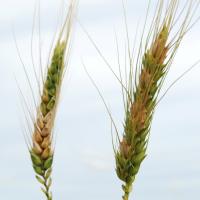Diagnosing fusarium head blight in cereals
A rare fungal disease occurring mainly in high rainfall areas that can significantly reduce grain yield and quality and which produces toxins affecting marketability.
What to look for
- Scattered, bleached spikelets or heads several weeks after flowering.
Paddock
- Pink or orange spores at edge of glumes.
- Grain shrivelled and discoloured white or pink.
- Seedlings can be blighted in young crops sown with infected seed.
Plant
What else could it be
| Condition | Similarities | Differences |
|---|---|---|
|
Frost, copper and molybdenum deficiency, spring drought, crown rot and take-all
|
White heads | Fusarium head blight can be distinguished from these by the scattered distribution of partially bleached heads, and pink / orange spores at the edge of glumes, with wet conditions |
Where did it come from?

Wet or humid conditions
- Risk of the disease is highest when winter cereals follow a summer cereal crop (maize, millet, sorghum) especially when stubble is retained.
- Head infection is favoured by moisture or high humidity around flowering time.
Management strategies
- There is no treatment available only preventative measures.
- Avoid multiple winter cereal crops, which can promote the disease once it is established.
- Do not sow winter cereals into summer crop paddocks until all summer residues have broken down. In addition avoid sowing winter cereals adjacent to those paddocks.
See also
Where to go for expert help
Page last updated: Thursday, 16 April 2015 - 10:25am


